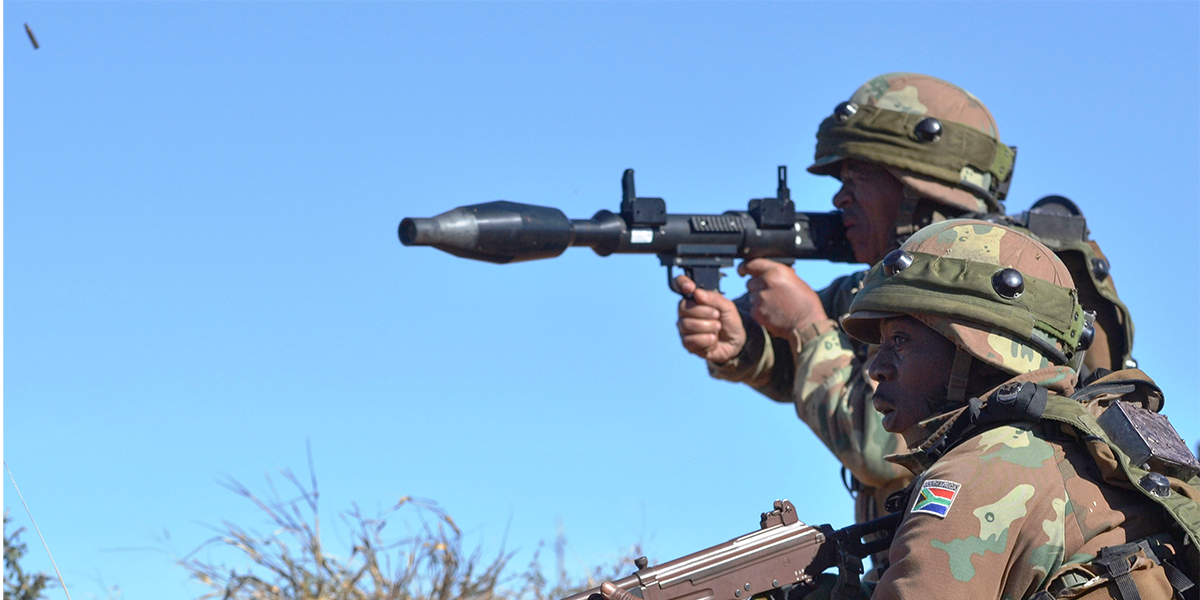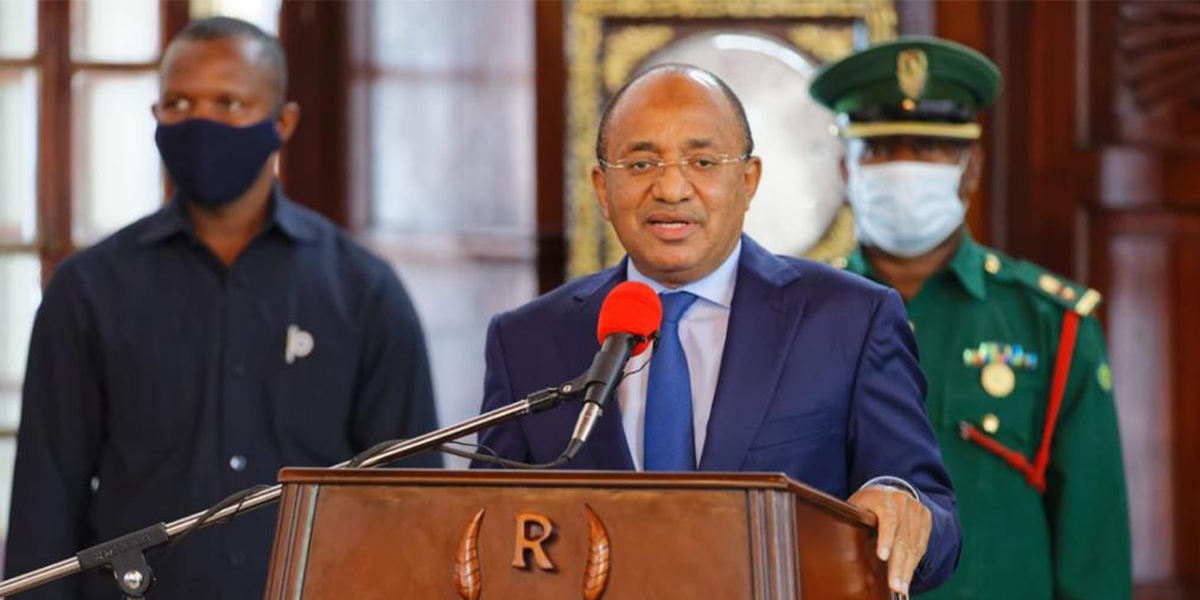News
A Reluctant Hegemon: The SANDF and its 'Defined' Role in Sub-Saharan Africa
In the wake of the July unrest and peacekeeping challenges on the continent, newly appointed SANDF head General Rudzani Maphwanya and his team must formulate, develop and adopt policy options at the strategic and tactical operational levels that will satisfy President Cyril Ramaphosa's expectations of 'ushering in substantial change'.

President Cyril Ramaphosa has replaced Defence Minister Nosiviwe Mapisa-Nqakula and moved state security into the Presidency following the failure of security force intelligence to predict and pre-empt the violence which flared across the country after the jailing of former president Jacob Zuma.
But how should the SANDF be restructured to align it with the country's priorities and to prevent a recurrence of these events?
At the end of May 2021, Ramaphosa announced sweeping changes to the new military command of the SANDF, following the retirement of the long-serving General Solly Zacharia Shoke. Shoke was replaced by Lieutenant-General (promoted to general on 1 June) Rudzani Maphwanya, accompanied by new appointments heading the other branches of the force.
In the president's view, the new appointments represented an opportunity to undertake “substantial change” in which he expected a “seamless and smooth” transition. The implications of the president's call were to urge the generals to develop and implement appropriate policy and organisational reforms within the security sector that would benefit the overall continuing attention towards the state formation of the country.
Conceptually, the transformation in the security sector envisaged by Ramaphosa was to address the complex and challenging state formation and institutional construction processes that include political, socioeconomic and security dimensions of a relatively youthful post-apartheid democracy. The message was against the background of what is now widely acknowledged as the major post-independence challenge facing African nations — establishing a viable and functional state.
Instead, throughout the continent, the African state is in crisis. Characterised by dysfunctional states lacking legitimacy, with some becoming victims and totally captured by factions of ruling political parties, or even families — as we have witnessed in Togo and Gabon — who have remained in power for more than 50 years.
But in the case of the SANDF, precisely what are the role challenges envisaged in order to establish and integrate the armed forces into the nation's developmental agenda? Stated differently, Maphwanya and his new team must formulate, develop and adopt appropriate policy options at the strategic and tactical operational levels that will satisfy the president's publicly stated expectations of “ushering in substantial change” from what has been the practice in the past.
Given the “marching orders” to the new military command by the South African president, as well as taking into account the uninspiring continental experience, this discussion offers some considered views on how the SANDF may execute its mandate through suggested strategic and structural approaches to result in comprehensive security-sector reform and alignment to national interests.
The SANDF's Military Command comprises an innovative delegation of sectoral responsibility, under the Chief of Defence Staff. This includes heads of the Army, Air Force, Navy, Military Health Services, the Chief Joint Operations, Head of Defence Intelligence, Logistics, Human Resources and the forces' Chief of Staff.
Furthermore, in making this statement, the president implies that the institution has to consider almost fundamental reforms to move it away from past experience.
Security sector
Significantly, he is making these comments against the background of widespread negative comments about the role and participation of elements of the security sector emerging from the State Capture inquiry, chaired by Deputy Chief Justice Raymond Zondo, as well as findings of commissioned reports, such as the High Level Review Panel Report on the State Security Agency, established during December 2018 and chaired by former minister Sydney Mufamadi.
To this end, the High Level Review Panel reveals the successful establishment of personalised and factionalised units within the State Security Agency and secret services with different reporting lines outside the constitutional provisions. Against this background, the motivation and need for comprehensive security-sector reform for South Africa has never been more urgent.
The challenge, therefore, remains for Maphwanya to come up with appropriate corrective measures designed to reset the national roles and functions of the SANDF to occur within the existing budgetary constraints. On this note, while Maphwanya is coming into office facing a R15-billion budget cut, available evidence also indicates almost consistent deficit funding on defence and security over the past three years, according to the Parliamentary Monitoring Group.
It is to his credit that Maphwanya has already raised concerns on “the diminishing allocation of resources with a deleterious impact on the defence industries such as Armscor and Denel with important downstream and upstream economic linkages under threat”.
On the question of the new role definition, a respected colleague and security analyst on the SANDF, Jakkie Cilliers, firmly asserting the point that urgent attention needs to be paid towards the reform of the SANDF, argues that the institution “be repurposed for African peace support operations, border protection and support to police (Defence Web, “SA intelligence agencies not up to scratch, time for change”, 22 July 2021).
However, this discussion suggests at least five priority areas, around which balance must be mediated for the security sector to begin to align itself to appropriate roles.
Threat analysis
In the southern African sub-region, South Africa is the only country that has not been under threat of invasion from any of its neighbours. This situation has not changed in the post-apartheid era. For Maphwanya and the Military Command, the challenge is therefore to forge an operational SANDF that operates on what is defined as defence diplomacy in its relationship with its neighbours.
Stated differently, the SANDF has to seriously engage and consider some of the defence and security options demanded, particularly by former liberation movements in government, while at the same time taking into account its own internal challenges, especially when this comes to budgetary commitments.
A singular example in recent times has been the call by Southern African Development Community (SADC) member states for South Africa to deploy its air assets in the region. Pretoria countered by asking for the other member states to provide for the much-needed and expensive fuel. Confronted with the realities of costs up front, the requests fizzled out, demonstrating that through defence diplomacy and realism, countries' defence and security structures can be challenged to move towards realism.
However, taking the wider picture into account, the actual threat to South Africa's stability is the absence of internal cohesion and the unattended consequences of increasing resource and access inequalities, as will be argued below. We examine the four areas that should now seize the minds of the new chief of the defence force and the Military Command.
First, almost without question, the SANDF must continue to be ready to fulfil the country's signed-up-to international security obligations. Furthermore, it is on this level that South Africa plays a unique role, participating with the elite international defence and security community where the country is invited to either join maritime naval exercises or even air and landward joint or multinational events because of the sophisticated assets that the country has.
Furthermore, South Africa is an acknowledged defence and security equipment manufacturer and weapons exporter, a role shaped and defined by the competitiveness of global markets. In sub-Saharan Africa, South Africa has no match for the inherited and economically integrated defence industry, with thousands of workers employed. This niche cannot be neglected, and in the planning and execution of the new mandate, attention must be paid to the public and private sectors whose management requires developing networked markets with sophistication.
On this, it is illustrative to acknowledge that already Maphwanya is on record committing to saving threatened defence industry companies while pointing out the detrimental effects of outsourcing, service, maintenance, repair, refit and supply of the basic weaponry needs of the SANDF. Significantly on this point, the general alludes to the security implications separate from the high cost of outsourcing.
The second area of participation which the new Military Command needs to consider is readiness to engage in peacekeeping, mandated by either the United Nations or the African Union (AU) and its sub-regional structures, organised as the African Peace and Security Architecture. To this end, cutting-edge technical and strategic assets, such as those available within the Force Intervention Brigade called to assist in the December 2013 crisis in the eastern Democratic Republic of Congo and South Sudanese city of Juba, represent the manifestation of this second layer of participation. In that operation, the SANDF demonstrated its highly sophisticated air assets and other intelligence-acquisition equipment not normally available to most African nations.
But it must be appreciated that this is but a secondary and technical area of participation that does not equate to the maritime or even air and cyber knowledge-sharing and exercises that the country is exposed to in the first category.
Furthermore, in response to continental demands, South Africa has just spent R984-million deploying 1,250 troops in the volatile Cabo Delgado Province of Mozambique, and which are scheduled to remain on the ground until 15 October 2021. This development is an example of the country's commitment to continental security under the auspices of the AU and the sub-regional SADC.

In an illustrative development, weeks before this deployment the US had publicly approached South Africa to suggest the country join the superpower in military collaboration against extremists operating in Cabo Delgado. This direct invitation came at the height of ongoing deliberations within the SADC on how the sub-region could invoke its own provisions under the auspices of the Organ of Defence and Politics. It is therefore important to take note that such overtures from the US to South Africa will continue and the country must prepare to participate in split roles.
The third area of attention for the new Military Command is to prepare for the traditional role of the armed forces, which is safeguarding the territorial integrity of South Africa on its borders, oceans and air space. Preparations include paying attention to human resource capacity and skills, as well as developing, deploying and maintaining appropriate equipment. This category also includes undertaking the actual reform and reconstruction specifically called for by the president.
Stated differently, each of the heads of command are not merely “robustly reconstructing their subdivisions or units”, but specifically exorcising the same from the negative attempts at creating parallel and unconstitutional elements operating, answerable only to a select political elite.
For instance, the newly appointed Chief of Defence Intelligence, Major-General Thalita Mxakato, has her work cut out if we consider the findings and recommendations of Mufamadi's High Level Review Panel on the country's secret service. Furthermore, evidence of the absence of defence intelligence was also revealed during the shocking mayhem and destruction during the riots, looting and threats to citizens with serious loss of life between 9 and 16 July 2021, as shall be fully discussed below.
The fourth suggestion towards reconstruction, refocusing and strategic as well as tactical deployment of the SANDF by Maphwanya and his new cadres is straightforward: working within constitutional parameters to support the civil power in the domestic arena. The events of July 2021 have shown serious flaws in the defence and security working intelligence and knowledge of South African society; a lack of anticipatory or reaction capacity, where internal peace and security is deliberately undermined; ignorance of potential and active perpetrators, leaving the organisation in the unenviable position of being “one of the spectators” and only able to act after the event.
To prove some of these points, this discussion will briefly look at the events during the second week of July that left the international community, investors and tourists shocked at the level of the breakdown of even citizens' security, resulting in the embassy of India, among others, urgently contacting the South African government for assurances on the safety of their citizens. This development was unprecedented and will have left a serious dent, particularly on the SANDF and its capacity to provide timely and effective security towards arresting what turned out to be a week of chaos and lawlessness in the country.
According to respected journalist, Daily Maverick's Ferial Haffajee*,* (see here and here) using empirical evidence, the sources of which researchers can trace and determine that the recent internal, almost complete breakdown in law and order in particularly KwaZulu-Natal and parts of the central province of Gauteng, began with a WhatsApp group calling themselves “Free Zuma Coordinators”, which later changed to “Free Zuma Information”.
Haffajee was also able to identify yet another group that encouraged upheaval, sharing incendiary materials fuelling the riots, looting and deliberate destruction of property, including killings. This was the INK WhatsApp group, representing satellites from Inanda, Ntuzuma and KwaMashu. The group emerged after Zuma had been imprisoned by the courts and was scheduled to report for incarceration. A palpable air of tension and potential conflict gripped the country, as the event also represented the factional struggle within the ruling ANC.
In response, the minister of defence and war veterans announced in Parliament the intention to deploy 2,500 soldiers for purposes of “assisting SAPS and other law and order agencies to restore the rule of law”. However, the decision was met with consternation, ridicule and derision by the media and security analysts given the shocking scale of the destruction. Overnight, the SANDF number to be deployed increased tenfold to 25,000 to be in place from 12 July — significantly three days after the beginning of the chaos on 9 July, and remain in place until 12 August, at a cost of R615,665,500, according to statistics available and released by the Parliamentary Monitoring Group.
But what then are the obvious security flaws that were revealed by the events that began with the jailing of Zuma on the night of 7 July to date?
The first point to note is that in retrospect, infighting at the ANC has had a deleterious effect on the structure, composition and operational efficiency of the SANDF. While this is unfortunate, it does confirm the continental trend of the failure to create national institutions, particularly on defence and security, as part of state formation. Instead, what emerges are convoluted structures and questionable command and control elements that are guided by the Constitution.
It has been widely acknowledged that the SAPS was aware of the imminent danger and plans for the shocking disruption, which continues to amaze security analysts and the international community. However, information appears not to have been shared, particularly with Defence Intelligence from the SANDF, which ultimately then took responsibility to restore order.
Professor Martin R Rupiya, PhD, is executive director at the Dag Hammarskjöld Institute for Peace and Conflict Studies.
This article was based on the discussion paper 'A Reluctant Hegemon: The SANDF and its 'defined' role in sub-Saharan Africa', which you can find here. It was originally published by Daily Maverick.


